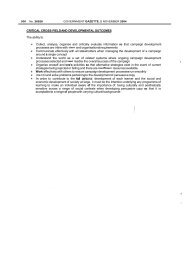The trafficking of children for purposes of sexual exploitation
The trafficking of children for purposes of sexual exploitation
The trafficking of children for purposes of sexual exploitation
You also want an ePaper? Increase the reach of your titles
YUMPU automatically turns print PDFs into web optimized ePapers that Google loves.
1.2. South African Print Media<br />
<strong>The</strong> print media, particularly newspapers and magazines are one <strong>of</strong> our most valuable sources <strong>of</strong><br />
in<strong>for</strong>mation on child <strong>sexual</strong> <strong>exploitation</strong> and, particularly, child prostitution. <strong>The</strong> value <strong>of</strong> these<br />
newspaper and magazine reports is that they<br />
• raise public awareness about the phenomenon, and<br />
• give <strong>children</strong> who are being exploited a voice by recording their words and attitudes about the<br />
manner in which they live.<br />
Newspaper and magazine articles have used investigative methods to create public awareness about<br />
child prostitution. <strong>The</strong>se sources also draw on reports from those who work with <strong>children</strong> at risk to<br />
highlight the factors that contribute to child <strong>sexual</strong> <strong>exploitation</strong>. Thus interviews are commonly<br />
conducted with social workers and police <strong>of</strong>ficers who work with street <strong>children</strong> or deal with<br />
families in distress.<br />
A survey <strong>of</strong> newspaper articles, in the English and Afrikaans press, <strong>for</strong> the period 1997 to March<br />
2000 indicated certain trends and factors which put <strong>children</strong> at risk <strong>of</strong> <strong>sexual</strong> <strong>exploitation</strong>. In<br />
addition, these articles also highlight the nature <strong>of</strong> the <strong>trafficking</strong> <strong>of</strong> <strong>children</strong> <strong>for</strong> the purpose <strong>of</strong><br />
<strong>sexual</strong> <strong>exploitation</strong>.<br />
National newspapers surveyed were <strong>The</strong> Sunday Times, <strong>The</strong> Sunday World, Rapport, <strong>The</strong> Sunday<br />
Independent, City Press, and <strong>The</strong> Mail & Guardian. Regional newspapers reviewed are the Pretoria<br />
News, <strong>The</strong> PE Herald, <strong>The</strong> Mercury, <strong>The</strong> Star, <strong>The</strong> Argus, <strong>The</strong> Sunday Tribune, <strong>The</strong> Sunday Argus,<br />
the Saturday Paper, <strong>The</strong> Saturday Argus, <strong>The</strong> Cape Times, Beeld, and Die Burger.<br />
<strong>The</strong>se articles highlight the fact that the <strong>sexual</strong> <strong>exploitation</strong> <strong>of</strong> <strong>children</strong> is the consequence <strong>of</strong> the<br />
interplay between macro, meso and micro factors. <strong>The</strong>se factors have been incorporated into the<br />
discussion on the nature <strong>of</strong> the in-country <strong>trafficking</strong> <strong>of</strong> girl <strong>children</strong> in Chapter 4.<br />
<strong>The</strong> media in general focus on child prostitution with regard to the following:<br />
• casual factors<br />
• incidence <strong>of</strong> the phenomenon<br />
• need <strong>for</strong> effective legislation<br />
• need <strong>for</strong> effective service provision.<br />
<strong>The</strong> combined effects <strong>of</strong> these factors result in the following patterns and trends with regard to both<br />
the <strong>sexual</strong> <strong>exploitation</strong> and the <strong>trafficking</strong> <strong>of</strong> <strong>children</strong> <strong>for</strong> this purpose.<br />
• <strong>The</strong> voluntary cross-country migration <strong>of</strong> girl <strong>children</strong>. This migration can be either from rural<br />
to urban areas or from city to city. <strong>The</strong>y are lured into the sex industry by men either on their<br />
way to the new city or are approached by these men shortly after they leave home<br />
• Girl <strong>children</strong> are sold by family members to brothels, syndicates and individual gang leaders,<br />
and as child brides to single men<br />
• Girl <strong>children</strong> are abducted, held captive, <strong>sexual</strong>ly assaulted and coerced into having sex with<br />
several men in exchange <strong>for</strong> money<br />
• Parents facilitate the <strong>sexual</strong> <strong>exploitation</strong> <strong>of</strong> their own <strong>children</strong><br />
• Boy <strong>children</strong> are voluntary migrants and engage in prostitution as a means to survive. Boy<br />
<strong>children</strong> engage mostly in homo<strong>sexual</strong> <strong>sexual</strong> activity. Some <strong>of</strong> these boy <strong>children</strong> are<br />
homo<strong>sexual</strong>, although most are hetero<strong>sexual</strong>.<br />
Another feature <strong>of</strong> newspapers is that their adult entertainment and employment sections advertise<br />
either the services <strong>of</strong> <strong>children</strong> or advertise <strong>for</strong> <strong>children</strong> to work in the industry. Advertisements <strong>for</strong><br />
sex with <strong>children</strong> typically appear in the <strong>for</strong>m <strong>of</strong> advertisements that advertise as "Barely Legal".<br />
<strong>The</strong> recruitment <strong>of</strong> teenage girls between 15 and 18 years <strong>of</strong> age into the sex industry happens<br />
through newspaper adverts such as the following:<br />
22
















